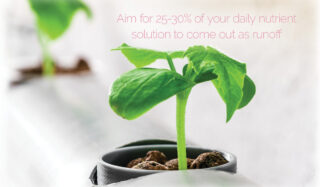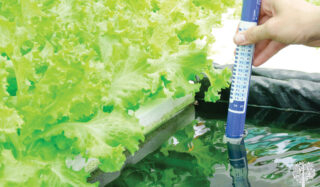How To Test Runoff When Growing In Soilless Substrates & Soilless Potting Mix
Everest Fernandez introduces the often-overlooked topic of testing runoff solution when growing in soilless substrates.
Confession time: During my first decade as a soilless gardener, I grew thousands of plants in stone wool, coco coir, and perlite without ever considering testing the runoff. Yes, you read that right. As someone who’s not shy about sharing his past mistakes on these pages (mercifully limited to indoor gardening), this oversight was huge. I’m ready to explain why testing your nutrient leachate is crucial for soilless growing. So, if you’re new to hydroponics or don’t know what runoff is, this one’s for you!
Why Should You Care About Runoff?
So, what exactly is runoff? It’s the excess nutrient solution that drains out of your pots, blocks, or slabs after watering. While some hydro setups naturally minimize or eliminate runoff (like passive wicking systems), irrigating your plants so runoff emerges from your soilless media is vital in top-fed systems with coco coir or stone wool.
Here’s my rule of thumb: Aim for 25-30% of your daily nutrient solution to come out as runoff. This practice helps prevent salt buildup in the root zone, which can otherwise wreak havoc on nutrient balance and stress your plants. Think of runoff like clearing the screen of an “Etch a Sketch”—it’s a fresh start.

Growing in soilless media is a different ballgame compared to soil-based container gardening. In pots filled with soilless substrates, the grower provides all the nutrients through the feeding solution. The growing medium primarily offers physical support, water retention, and nutrient storage. This makes it super important to keep tabs on the nutrient environment—and that’s where runoff testing comes into play. Compare this with soil-based potting mixes, where growers aim to minimize runoff to avoid flushing away valuable nutrients.
Neglecting to create runoff when growing in soilless mixes (essentially, underwatering) can lead to nasty consequences like salt buildup, which results in nutrient toxicity. The symptoms—burnt leaf tips, stunted growth, and reduced yields—stem from the selective absorption of nutrients like nitrate, potassium, and phosphorus, while others like sodium, chloride, and magnesium accumulate. Over time, this imbalance stresses your plants and hinders their ability to take up water and nutrients.
Environmental Factors and Their Impact on Runoff
Nutrient management should always be considered within the context of your environmental conditions. High air temperatures, low humidity, and intense lighting significantly affect plant health and nutrient uptake, impacting runoff pH and EC.
High Air Temperatures
Elevated temperatures accelerate plant metabolism and increase transpiration, leading to rapid salt accumulation in the root zone and higher runoff EC. In extreme cases, high temperatures can cause nutrient imbalances or deficiencies when roots struggle to meet increased demand.
Low Humidity
Low humidity levels create a high vapor pressure deficit, forcing plants to transpire more rapidly. This leads to higher nutrient concentrations in the root zone, as water evaporates faster than nutrients are absorbed. If increasing humidity isn’t an option, lowering the feed solution concentration is the next best step.
Intense LED Lighting
High-intensity lighting, especially in LED grow rooms, can markedly increase the demand for water and nutrients, causing issues similar to those caused by high temperatures and low humidity. Photoinhibition or light stress can accumulate unused nutrients in the root zone, impacting runoff EC and pH. Use a dimmer to incrementally adjust light intensity to help mitigate these issues.
The Role of Organic Additives and Compost Teas
Organic additives like compost teas and hydroponic supplements can significantly influence the pH stability of your nutrient solution and runoff.
Compost Teas
Rich in organic acids, compost teas can lower the pH of the nutrient solution, leading to a drop in runoff pH. Additionally, the microbial activity they stimulate can alter nutrient dynamics in the root zone, sometimes causing unexpected pH fluctuations.
Other Organic Additives
Products like humic and fulvic acids, liquid seaweed, and fish emulsions improve nutrient uptake and plant resilience. However, these additives can also affect pH stability, as humic and fulvic acids can chelate nutrients, potentially leading to fluctuations in pH and EC.
What Makes a Nutrient Solution pH Stable?
Several factors contribute to pH stability in a nutrient solution:
Buffering Capacity
The presence of bicarbonates, carbonates, and other buffering agents helps maintain pH stability by neutralizing acids or bases that might otherwise cause fluctuations.
Nutrient Composition
The types and ratios of nutrients play a crucial role. Nitrate-based nitrogen raises pH, while ammonium-based nitrogen lowers it. Professional hydroponic nutrient blends often balance these opposing effects to stabilize pH.

Water Quality
High alkalinity or mineral content in water can cause pH instability. Using reverse osmosis (RO) water or pre-treating water can help create a more stable pH environment.
How to Test Runoff
Testing runoff is straightforward. Measure two things: electrical conductivity (EC) (or Total Dissolved Solids (TDS)) and pH. Start by collecting about 150 ml of runoff after watering. Compare the runoff EC / TDS to your input nutrient solution. If the runoff is more than 20-25% higher, it indicates salt buildup. This can result from under-watering, poor drainage, or over-fertilisation. Gradually reduce the nutrient solution strength until the runoff stabilizes, and consider more frequent or longer irrigation events to generate more runoff.
When mixing a remedial feed solution, consider symmetry. For example, if your input solution has an EC of 2.0 mS and your runoff is 2.5 mS, aim to decrease your feed strength incrementally to 1.5–1.9 mS until the runoff returns to your target of 2.0 mS.
Conversely, if your runoff EC is lower than your input (though less common), it could indicate rapid nutrient uptake or nutrient retention by the medium. This sometimes happens when plants take up EC-contributing ions like nitrate, potassium, or calcium. Consider reducing irrigation frequency or slightly increasing nutrient strength—but make changes gradually.
What About Runoff pH?
A rise in pH could indicate your medium is releasing basic cations, leading to alkalinity. A decrease in pH might signal acidification from nitrate uptake or acidic residues in the root zone. To maintain balance, adjust the pH of your feed solution in the opposite direction of the shift observed in the runoff.
Also, keep an eye on your plants! Pathogens like Pythium (root rot) or Phytophthora can quickly damage the root system, disrupting normal nutrient and water uptake and leading to unexpected pH changes. Compromised roots may fail to absorb acidic nutrients like ammonium efficiently, causing pH to rise. However, to confuse matters, dying roots might release acidic compounds into the medium as they decompose, lowering pH!
When’s the Best Time to Collect Runoff?
Timing is critical when collecting runoff. Collecting it as soon as it appears provides a snapshot of the root zone’s condition, especially after an overnight dry-back period. However, waiting until runoff has flowed for a minute gives a more comprehensive sample, reflecting the entire root zone, including accumulated salts or nutrient deposits.
Try collecting a composite sample over the entire irrigation cycle for consistent data. This method averages out variations within the root zone, making it helpful in identifying long-term trends. However, be cautious, as this approach can mask localised nutrient imbalances.

Responding To Your Runoff Data
Once you’ve got your EC and pH readings, it’s time to put on your detective hat. High EC in the runoff could mean your plants struggle with salt buildup from over-fertilizing or poor drainage. Low EC might suggest your plants are underfed or that you’re not allowing sufficient dry-back with overly-frequent feedings.
pH fluctuations indicate issues with your water source, growing medium, or nutrient solution. The goal is to keep your root zone happy and stable, with a pH typically between 5.5 and 6.5 for most soilless systems. Regularly testing your runoff and making informed tweaks based on your findings will help prevent a nutrient lockout, reduce plant stress, and optimize growth and yield.
Looking at some hobby indoor grows online, it’s clear I’m not the only one who’s neglected runoff testing. It’s not just an optional extra—it’s a must for anyone serious about mastering soilless growing. You’ll gain valuable insights into what’s happening in your root zone and be able to make the necessary adjustments to keep your plants thriving.
Once runoff testing becomes a daily habit, it will become second nature. You’ll sidestep the pitfalls of salt buildup, nutrient imbalances, and pH fluctuations before they become visible in the aerial parts of your plants. Remember, consistency is vital—the more regular your testing and tweaks are, the happier and more productive your plants will be.